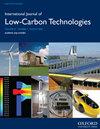基于生物质气化和熔融碳酸盐燃料电池的能源循环中二氧化碳减排的评估;演习经济和环境分析
IF 2.3
4区 工程技术
Q3 ENERGY & FUELS
引用次数: 1
摘要
熔融碳酸盐燃料电池(MCFC)驱动的能源过程的竞争优势在于其燃料的多功能性。另一方面,由于MCFC消耗二氧化碳,与其他燃料电池相比,它可以减少二氧化碳的排放量。因此,本文开发并评价了一种基于重整器MCFC堆和生物质气化过程的新型混合能源工艺(HEP)的热力学、燃烧经济和环境分析。均匀点火发动机(HIE)和热回收系统是所开发的HEP中嵌入的另外两个主要单元。在开发的循环中,MCFC和HIE产生电能,所需的燃料分别由生物质气化过程中获得的合成气和阳极废气提供。热回收系统还通过回收MCFC和HIE的热能,建立了能量循环的热平衡。本工作的目的是对所提出的能源系统进行多方面的评估,以进行富有成效的实施可行性分析。结果表明,规划的HEP获得的电功率和热功率分别接近1112 kW和367 kW。此外,电力、总功率和总能源的计算效率分别为51.5%、55.7%和69.9%。开发的HEP与石油发电厂相比,二氧化碳排放量减少48%,与天然气发电厂相比减少15.8%,与燃煤发电厂相比减少约63%。本文章由计算机程序翻译,如有差异,请以英文原文为准。
Evaluation of carbon dioxide emission reduction in an energy cycle based on biomass gasification and molten carbonate fuel cell; Exergoeconomic and environmental analysis
A competitive advantage for the molten carbonate fuel cell (MCFC)-driven energy processes is their fuel versatility. On the other hand, since MCFC consumes carbon dioxide, it can reduce the amount of carbon dioxide emissions compared to other fuel cells. Accordingly, the current paper develops and evaluates the thermodynamic, exergoeconomic and environmental analysis of a new hybrid energy process (HEP) based on a reformer MCFC stack and a biomass gasification process. A homogeneous ignition engine (HIE) and a heat recovery system are two other main units embedded in the developed HEP. In the developed cycle, MCFC and HIE produce electric energy, for which the required fuel is supplied through the obtained syngas from the biomass gasification process and the anode off-gas, respectively. The heat recovery system also leads to the establishment of the thermal balance of the energy cycle by recovering the thermal energies of the MCFC and HIE. The aim of the present work is to develop the multi-aspect evaluation of the proposed energy system toward a fruitful implementation feasibility analysis. The outcomes indicated that, the rates of electrical and thermal powers obtained from the planned HEP were equal to nearly 1112 kW and 367 kW, respectively. Further, the calculated efficiencies for electric, gross power and total energy terms were equal to 51.5%, 55.7%, and 69.9%, respectively. The developed HEP had 48% less carbon dioxide emissions compared to an petroleum-fired power plant, 15.8% less compared to a natural gas-fired plant, and approximately 63% lower compared to a coal-fired power plant.
求助全文
通过发布文献求助,成功后即可免费获取论文全文。
去求助
来源期刊

International Journal of Low-carbon Technologies
Engineering-Architecture
CiteScore
4.30
自引率
4.30%
发文量
106
审稿时长
27 weeks
期刊介绍:
The International Journal of Low-Carbon Technologies is a quarterly publication concerned with the challenge of climate change and its effects on the built environment and sustainability. The Journal publishes original, quality research papers on issues of climate change, sustainable development and the built environment related to architecture, building services engineering, civil engineering, building engineering, urban design and other disciplines. It features in-depth articles, technical notes, review papers, book reviews and special issues devoted to international conferences. The journal encourages submissions related to interdisciplinary research in the built environment. The journal is available in paper and electronic formats. All articles are peer-reviewed by leading experts in the field.
 求助内容:
求助内容: 应助结果提醒方式:
应助结果提醒方式:


